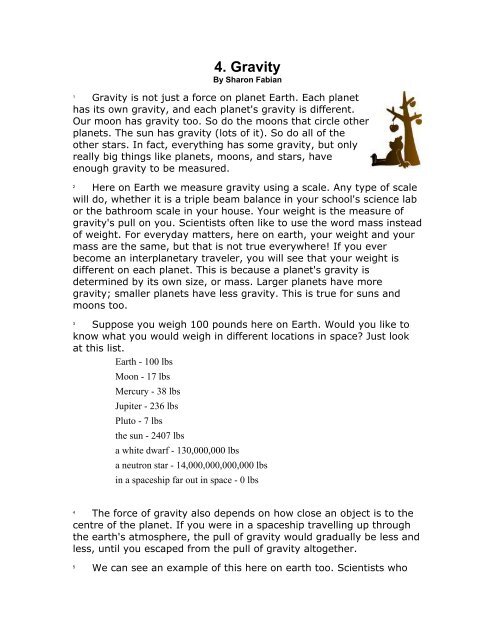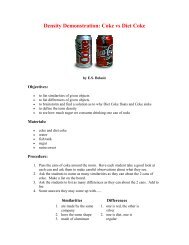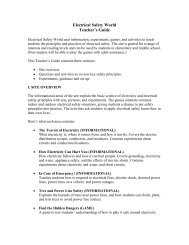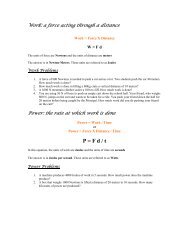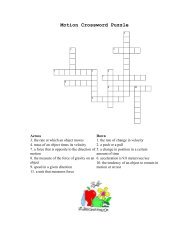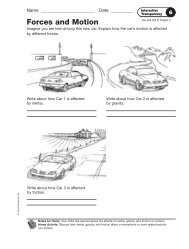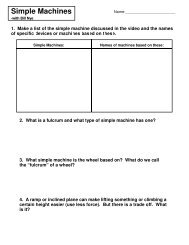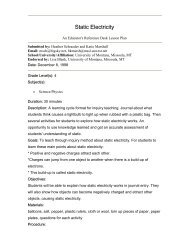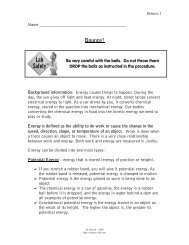Gravity By Sharon Fabian
Gravity By Sharon Fabian
Gravity By Sharon Fabian
- No tags were found...
You also want an ePaper? Increase the reach of your titles
YUMPU automatically turns print PDFs into web optimized ePapers that Google loves.
4. <strong>Gravity</strong><strong>By</strong> <strong>Sharon</strong> <strong>Fabian</strong>1<strong>Gravity</strong> is not just a force on planet Earth. Each planethas its own gravity, and each planet's gravity is different.Our moon has gravity too. So do the moons that circle otherplanets. The sun has gravity (lots of it). So do all of theother stars. In fact, everything has some gravity, but onlyreally big things like planets, moons, and stars, haveenough gravity to be measured.2Here on Earth we measure gravity using a scale. Any type of scalewill do, whether it is a triple beam balance in your school's science labor the bathroom scale in your house. Your weight is the measure ofgravity's pull on you. Scientists often like to use the word mass insteadof weight. For everyday matters, here on earth, your weight and yourmass are the same, but that is not true everywhere! If you everbecome an interplanetary traveler, you will see that your weight isdifferent on each planet. This is because a planet's gravity isdetermined by its own size, or mass. Larger planets have moregravity; smaller planets have less gravity. This is true for suns andmoons too.3Suppose you weigh 100 pounds here on Earth. Would you like toknow what you would weigh in different locations in space? Just lookat this list.Earth - 100 lbsMoon - 17 lbsMercury - 38 lbsJupiter - 236 lbsPluto - 7 lbsthe sun - 2407 lbsa white dwarf - 130,000,000 lbsa neutron star - 14,000,000,000,000 lbsin a spaceship far out in space - 0 lbs4The force of gravity also depends on how close an object is to thecentre of the planet. If you were in a spaceship travelling up throughthe earth's atmosphere, the pull of gravity would gradually be less andless, until you escaped from the pull of gravity altogether.5We can see an example of this here on earth too. Scientists who
study the oceans' tides know that tides are caused mainly by the pullof the moon's gravity, but also, just a little bit, by the pull of the sun.The reason why the moon's pull is so much stronger is because, eventhough it is much smaller than the sun, it is also much, much closer toearth.6<strong>Gravity</strong> is the force that holds moons in their orbit abound theirplanet, and planets in their orbit around the sun. Without gravity,moons, planets, or anything else would just keep going in a straightline. There is a special name for a force that holds something in acircular path. It is called centripetal force.7Space scientists have found an amazing use for planets' centripetalforce. They have sent up the spacecraft named Cassini to explore thefar away planets. Cassini could never carry enough fuel for its wholemission, so the scientists planned to have it do a flyby of severalplanets on its way. As it zips around each planet, it uses that planet'sgravity, or centripetal force, to pick up speed. Cassini's missionincluded a flyby of Venus, Earth, and Jupiter, which all together wouldpick up as much power as 75 tons of rocket fuel.8The next time someone tells you that gravity is what holds usdown on Earth, you can say that there is a lot more to gravity thanthat!
<strong>Gravity</strong>1. If you weigh 100 pounds on Earth howmuch would you weigh on Jupiter?17 lbs100 lbs2407 lbs236 lbs3. On Mercury, you would weighMore than an elephantLess than on EarthThe same as on EarthMore than on Earth5. Tides are mainly caused byThe sun's gravityNone of theseThe moon's gravityThe Earth's gravity7. The force that holds the planets in theirorbit around the sun is calledWeightMassCentrifugal forceCentripetal force2. <strong>Gravity</strong> is measured using aRulerScaleMeasuring cupSpeedometer4. On a neutron star, you would weighAbout as much as a train weighson earthAbout as much as an elephantweighs on EarthAbout the same as on EarthMuch more than any of these6. From the information in the article, wecan infer that an object's massWould be greater on Jupiter thanon EarthWould be less on Jupiter than onEarthWould always be the sameWould be more on Jupiter thanon Mercury8. How did scientists use the force ofgravity on the Cassini spacecraftmission?<strong>Gravity</strong> pulls Cassini back toEarth from outer space.Cassini gets a power boost fromplanets' gravity.Cassini uses the Earth's gravityto help it blast off.<strong>Gravity</strong> keeps Cassini fromcrashing into Jupiter.
5. The Story Behind Our Seasons<strong>By</strong> Laura G. Smith1Maybe the summer season is your favourite time of year-school'sout, the weather's warm-you might take a trip to the beach or hangout at your neighbourhood pool. The fall season usually makes usthink of leaves changing colours or the kick-off of a new footballseason. Then the winter months follow, bringing colder air and maybesnow for sledding or an icy pond for skating. Maybe spring is theseason you look forward to the most! The blossoming trees andflowers can surely brighten things up after the drab, grey days ofwinter. All four of the seasons display their own unique characteristics,but what causes the change?2There are two things that cause the change in seasons: the earth'sorbit (the path it travels around the sun), and the tilt of the earth'saxis (which is at an angle of 23.5 degrees).3It takes the earth one year to make a single orbit (or revolution).At the same time the earth is revolving around the sun, it is alsospinning (or rotating) on its axis. The earth completes one rotationevery 24 hours. (Read about the earth's 24 time zones in "It's AboutTime.")4If you could stick a huge straight pin down through the North Poleand have it poke out through the South Pole, the pin would representthe earth's axis, but it would not be straight up and down. It wouldactually be slanted at an angle. The angle of the earth's axis is whatcauses different seasons. In summer, the earth is tipped toward thesun; in winter, it's tipped away. When it is summer in the northernhemisphere, it is winter in the southern.5If the earth's axis were not tilted, but straight up and down (orvertical), each location on earth would be exposed to a constantamount of sunlight during the entire year; there would be no changesin temperatures and no seasons! The regions near the equator wouldreceive the most sunlight (much like they already do); the land at thenorth and south poles would receive almost no sunlight, so it wouldalways be dark and winter-like. The regions between the equator andthe poles would be warmest by the equator and then gradually cool offas we moved towards the poles. None of these regions would have achange in seasons. For example, if the weather in South Carolina wasin the 70's during the month of April, it would also be in the 70's inAugust or December or any other month of the year.6On the other hand, if the earth were tilted at an angle much
greater than its current 23.5 degrees, let's say it was tilted at closer to90 degrees, what would happen then? The northern hemisphere wouldexperience very severe cold weather for about a six-month period oftime in the winter; and the southern hemisphere would have anextremely hot, six-month-long summer. The conditions for thenorthern and southern hemispheres would be reversed for the secondhalf of each year. This would no doubt impact plant and animal life onearth as we now know it.7Our Earth is an amazingly complex habitat! It was designed toprovide a place where humans, animals, and vegetation would thrive.Just observe the consistent, systematic movement of our planet. Wecan count on the sun "rising" and "setting" at predictable times eachday because the earth rotates every 24 hours. We know the earth willcontinue to travel around the sun every 365 days; and its axis willalways be tilted at 23.5 degrees so we can look forward to thechanging seasons, which occur like clockwork.
The Story Behind Our Seasons1. The two things that cause our changein seasons are:Changes in the environment andthe sun's raysThe earth's orbit and the tilt ofits axisThe earth's rotations andrevolutionsRainfall and temperatures3. It takes 24 hours for the earth to makea singleCircleRevolutionRotationOrbit5. If the earth's axis were perfectlyvertical, we would not haveLightSeasonsRainHeat7. When the northern hemisphere istipped toward the sun, it is_____________ in the southernhemisphere.WinterSummer2. When the earth travels once around thesun, we call this aRotationAxisSeasonRevolution4. The earth's axis is perfectly vertical(straight up and down).TrueFalse6. The earth's axis is tilted at an angle of_____ degrees.12.553.523.590.58. My favourite season is______________ because___________________________
6. It's About Time<strong>By</strong> Laura G. Smith1"Do you know what time it is?" It's a question we either ask oranswer nearly every day. We plan to do certain things, meet certainpeople, or go to certain places at certain times, based on ourschedules. Imagine how confusing our days would be if we had noorganized way to measure time!2Before timekeeping and clocks were invented, people used to knowapproximately what time it was by watching the sun. When the sun isat its highest point in the sky, this is known to be 12 o'clock noon (ormidday). Directly above every spot on the earth, an imaginary curvedline called the celestial meridian passes through the sky. As the earthrotates on its axis (read more about the earth's axis in "The StoryBehind the Seasons"), the sun crosses every celestial meridian onceeach day. When the sun crosses the celestial meridian above aparticular place, the time there is noon. Every place on earth that iseast or west of another place has noon at a different time. The time atany particular place is called the local time.3<strong>By</strong> the 1700's man had developed accurate clocks and watchesthat told time to the minute. Each town would set their clocks at nooneach day based on the position of the sun. The town clock would bethe "official" local time, and the citizens would set their pocket watchesand clocks to the same time. Some of the townspeople even earnedmoney by traveling house-to-house adjusting clocks in theircustomers' homes on a weekly basis. Since each town set its officialclock according to the position of the sun at that particular location,travel between cities meant having to change one's pocket watch uponarrival.4As railroads grew to be a more widespread mode of transportation,time became a more important issue. In the early years of therailroads, the schedules were very confusing because each stop wasbased on a different local time.5In 1878, Sir Sanford Fleming, a Canadian civil engineer and builderof the Canadian Pacific (CP) Railway across Canada, proposed that theworld should be divided into twenty-four time zones. Sir Fleming's ideawas recognized worldwide as a brilliant solution to a chaotic problemand earned him the title of "Father of Standard Time."6Over the years, various railroads had simplified their schedules byestablishing what they called railroad time along their routes. But by1883, there were still about 100 different railroad times. On November
18, 1883, United States railroad companies began utilizing Fleming'sstandard twenty-four time zones that are still in use today.7In 1884 an International Prime Meridian Conference was held inWashington D.C. During this conference, the Greenwich Observatory inEngland was chosen as the prime meridian (or starting point) for thetime zones. Twelve time zones were established to the west ofGreenwich and twelve to the east.8The time is the same everywhere within one time zone, butdifferent to the remaining twenty-three zones. When you move fromone zone to the next, you change your watch by one hour. If you aretravelling in an easterly direction, you move your watch forward byone hour. If you are moving westerly, you move it one hourbackwards.9The "twelfth zone east" and "twelfth zone west" lie next to eachother and are separated by an imaginary line called the InternationalDate Line, which is halfway around the world from Greenwich. Atraveler crossing this line while headed west, towards China, loses aday. If he crosses it traveling eastward, he gains a day.10The International Date Line is not a straight line. It runs in azigzag pattern to avoid splitting countries apart into two days.However, the tiny country of Kiribati was originally separated by theline causing the western part to be a whole day and two hours behindthe eastern part. In 1995, Kiribati moved the International Date Lineso the entire country would be on the same day at the same time.Since there are no treaties or formal agreements establishedinternationally concerning the line, the rest of the world followedKiribati and moved the line.11The U.S.A. and its territories have nine time zones. They includeEastern, Central, Mountain, Pacific, Alaska, Hawaii-Aleutian, Samoa,Wake Island, and Guam.In Canada there are 5 ½ time zones. Pacific Standard, MountainStandard, Central Standard, Eastern Standard, Atlantic Standard andNewfoundland Standard which is ½ hour different than AtlanticStandard.
It's About Time1. Before man invented timekeepingdevices, how did people know whattime it was?<strong>By</strong> word of mouth<strong>By</strong> observing the position of themoon<strong>By</strong> ringing the church bells<strong>By</strong> observing the position of thesun3. The time at any particular place isreferred to as the _________ time.LocalCurrentPrimeOfficial5. The issue of keeping track of timebecame more important because of thePeople arriving late to workDevelopment of more townsIncrease in populationDevelopment of the railroadsystem7. When you travel across theInternational Date Line, you either loseor gain a day, depending whichdirection you're traveling.TrueFalse2. Above every spot on the earth, animaginary curved line called the _____passes through the sky.Prime meridianInternational Date LineCelestial meridianLocal time4. When the sun crosses the celestialmeridian above a particular place, thetime there isTen o'clockMidnightNoonTwo o'clock6. The starting point for the 24 timezones is called theBasic meridianPrime meridianFather of TimeFleming's Line8. Imagine you were travelling from theProvince of B.C. in an easterlydirection. During the course of yourtrip, you left the Pacific time zone,passed through the Mountain timezone and drove into the Central timezone where you stopped to spend thenight. If you had left home (inVancouver) at 6:00 a.m. that morningand travelled for 12 hours beforestopping for the night, what timewould you have to adjust your watchto in the Central Time Zone?8:00 p.m.6:00 p.m.9:00 p.m.7:00 p.m.


